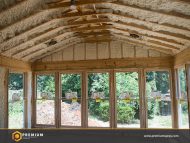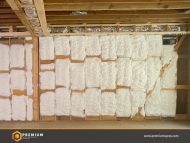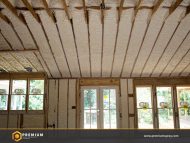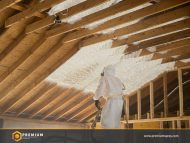Residential
A building that allows air to pass through walls, ceilings and floors is not only leaking air—it’s leaking money in utility costs, month after month.
Our Foamsulate™ series of open and closed cell spray foam products control air leakage better than traditional materials because they provide a precision fit, forming a tight seal in any crack, crevice, or gap to keep temperature-controlled air where it’s supposed to be: indoors.
New Construction
Used throughout a new structure, our Foamsulate series products create a tight thermal envelope around the entire building for reduced heating and cooling costs, improved air quality, noise reduction and stronger structural integrity. It’s the most cost- effective way to protect indoor air: using Foamsulate, it only costs two to four percent more (excluding tax credits) upfront to build a home that uses up to 60% less energy than conventional construction. In fact, Foamsulate typically pays for itself in energy savings in just 5 years.
Retro-fits and Remodels
If you’re renovating an existing structure, Foamsulate allows you to bring your construction to the highest of today’s standards for sustainability, energy efficiency, structural integrity and air quality, plus realize immediate monthly savings in energy costs. Reducing an existing structure’s energy efficiency through smarter insulation and roofing not only lowers the bills; it increases the value of the structure as well.
Special Projects
Whether you’re insulating a wine cellar with precision temperature controls, protecting a storage building against the elements or even working on an essential upgrade like Wind Uplift Resistance Programs in hurricane zones, our high-tech polyurethane insulation, roofing and coating products give your project superior air quality and temperature control, weather resistance and added structural strength.
Residential uses for Foamsulate™ Series Products:
- Exterior walls
- Interior walls
- Vented attics
- Unvented attic assemblies
- Between floors
- Uninsulated basement walls
- Foundations
- Crawlspaces
- Plumbing penetrations
- HVAC ducts
Need Someone to Install Foamsulate in your Home?
CLICK HERE to tap into Our Network of Trusted Professionals
FAQ's
-
Is spray polyurethane insulation code approved?
- Yes. Building codes provide for the use of spray polyurethane insulation in the Foam Plastic section. This section of the code also describes the use of thermal barriers.
-
Will spray polyurethane insulation strengthen my house?
- Yes! Closed cell foam is rigid and structural. Your walls will be more resistant to winds and you’ll notice less creaking and shaking when doors are slammed or when the kids are romping about.
-
Doesn’t it cost a lot of money to go green? Is there a return on investment?
- Not only is going green affordable, but the financial and health benefits far outweigh the initial costs. We estimate that it costs from two to four percent more (excluding tax credits) upfront to build a home that uses up to 60% less energy than conventional construction. In fact, the typical payback period is less than five years. You enjoy immediate monthly savings and in most instances can increase the value of your home. In addition, improving the tightness of your home and ventilating properly can result in a healthier environment for you and your family.
-
Can a homeowner apply spray polyurethane insulation?
- Not practically. Spray polyurethane application requires complex equipment and a skilled installer.
-
How does spray foam work?
- A two-part mixture is applied by trained professionals to the inside surface of exterior walls, to the underside of the roof, and beneath floors in basements and crawl spaces. The spray mixture expands rapidly to fill all cracks and voids, completely and permanently adhering to wood, masonry, metal studs and joists.
-
How long has SPF been around?
- Spray polyurethane foam was first used commercially in the US in the 1960s for cold storage and industrial insulation projects. SPF roofing systems evolved from exterior applications to tanks and pipes in the late 60s to early 70s.




